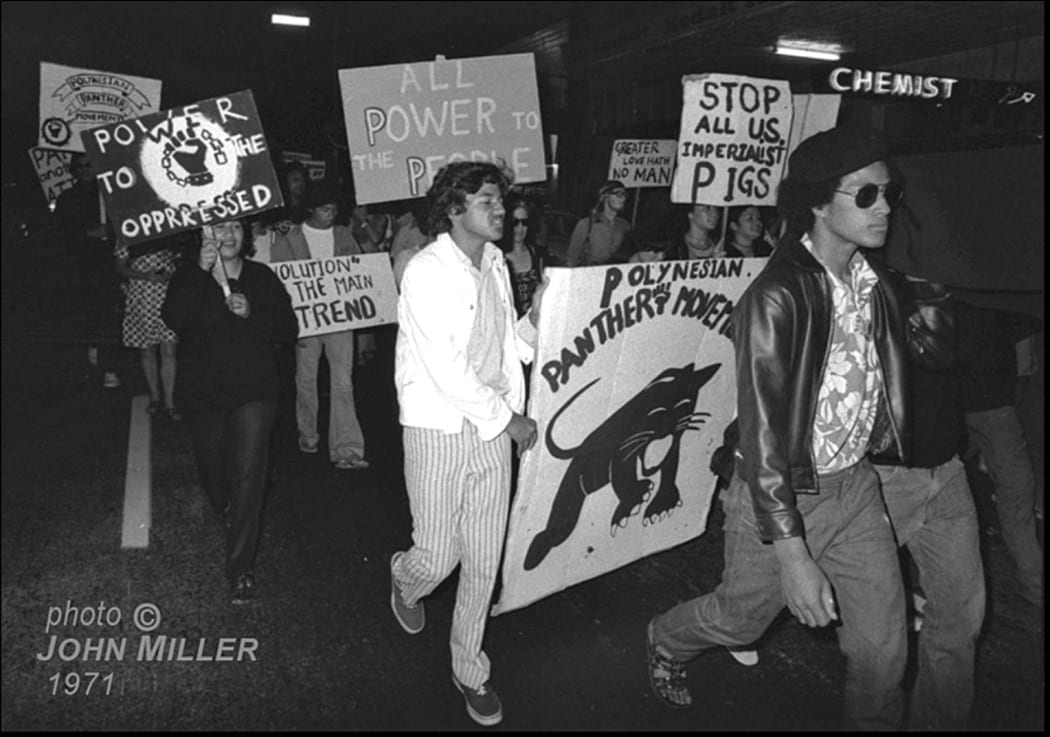
The Polynesian Panthers at a protest rally in the 1970s. Photo: John Miller
It was a cold winter’s night when Melani Anae snuck out of home and headed for Keppell Street, Grey Lynn, where a group of teenagers were gathering to, in their words, start a revolution.
“We couldn’t tell our parents, ‘oh we’re just going down the road for a Panther meeting’ with these ex-gang guys,” recalled Anae. “Especially for us girls who were just starting university and were good church girls.”
But they were all at the house with a purpose: to push back against racism and to form the group that would become known as the Polynesian Panthers.
“We knew this was different,” Anae said.
“We heard the leaders speak, we heard the platform and we were inspired to be part of that.”
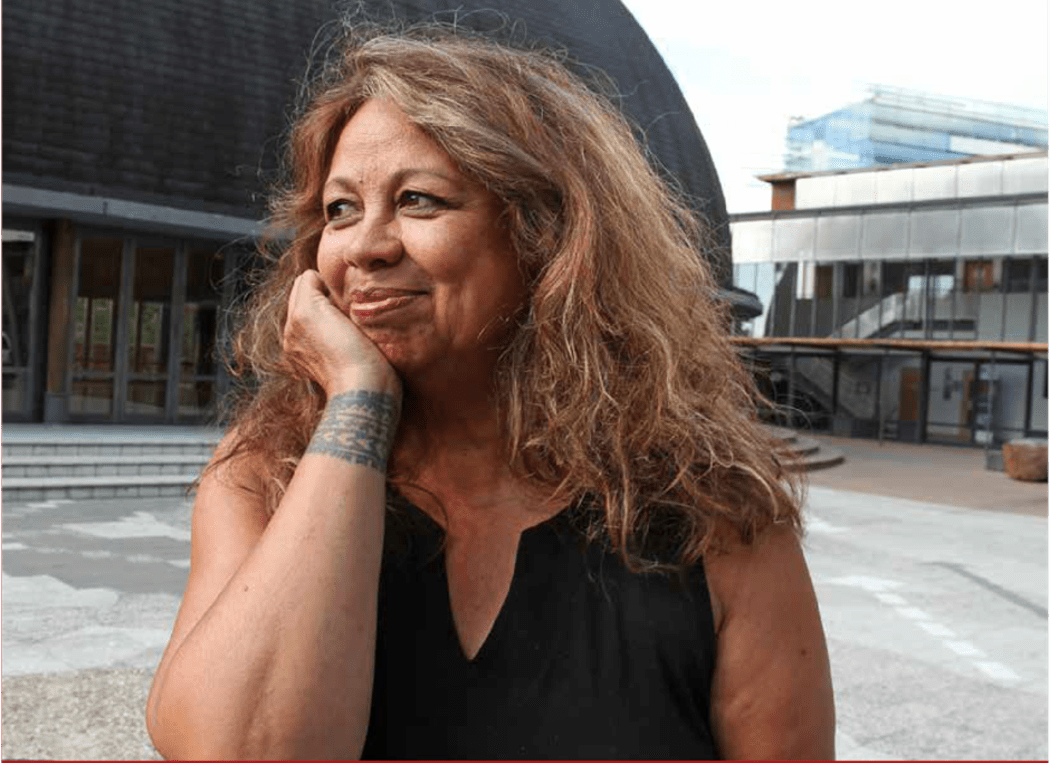
Lupematasila Misatauveve Dr Melani Anae outside the University of Auckland's Centre of Pacific Studies Photo: Miranda Playfair
Molded in the shape of the Black Panthers, the Polynesian Panthers was formed in Auckland in June 1971. One of its co-founders was Will ‘Ilolahia, who had been inspired by the works of Bobby Seale, Malcolm X and other US civil rights leaders.
“When we looked at their ten-point platform, it was relevant to us,” he said. “Barring the (carrying of) arms, everything else that we saw and experienced actually was to the point,” said ‘Ilolahia.
“Legal rights, education … housing. We just translated it to be relevant to our times here, and that’s how we started up."
Those times were 1970s Auckland where the Panthers were formed in response to the marginalisation and discrimination experienced by the Pacific community.
From the 1940s to the 1960s, Pacific migrants had been encouraged to come to New Zealand to fill gaps in the labour market, often in poorly paid and back-breaking manual work.
They flocked mostly to Auckland, where they filled the inner-city suburbs of Ponsonby and Grey Lynn, an area that became known as ‘Little Polynesia.’ Entire families filled houses; the first Pacific church opened in Newton and crowds were drawn to Karangahape Road to shop and mingle.
But the area was also run down and impoverished, with families living in houses that ‘Ilolahia said should have been condemned, and where violence and gangs flourished.
As the economy plunged in the early 1970s, the spotlight – and the blame – was turned to immigrants and overstayers which eventually led to the dawn raids that began in 1974.
Started by the third Labour government of Norman Kirk and Bill Rowling, the raids accelerated under the National government of Robert Muldoon.
Pasifika were stopped for random checks in the street. If they didn't have their passports or visas on them, they were hauled off. Factories were raided, so were Ponsonby bars. A special taskforce was formed to scour the streets.
William “Billy” Bates was a teen working at a laundry in Newmarket when he had his run-in with the taskforce.
“I was waiting for a taxi and I had my washing, which I did at work, and you’re just constantly being hassled by the police. These are detectives who’d say, ‘I’ll throw you off the wharf’ and that sort of rubbish.”
“They just hassled people for nothing,” said Bates, who as a Cook Islander is a New Zealand citizen. That experience was also had by many Māori who also reported being stopped and asked for their passports or visas, adding to the suspicion that the crackdown was based on race.
In the 1970s most overstayers in New Zealand were from Britain and Europe. Those communities were targeted in nothing like the same manner.
Another early Panther, Tigilau Ness, said the harassment reflected attitudes towards Pacific people that ran deep at the time. For him, it extended as far as his haircut, as he discovered when he was called into the principal’s office at Mt Albert Grammar.
“I had a big afro at the time, a lot of us Pacific Islanders had afros,” he recalled. “I was quite proud of my afro until he told me to get a haircut. I refused and I tried to tell him that culturally Niue has a haircutting ceremony for the eldest son, which I was.”
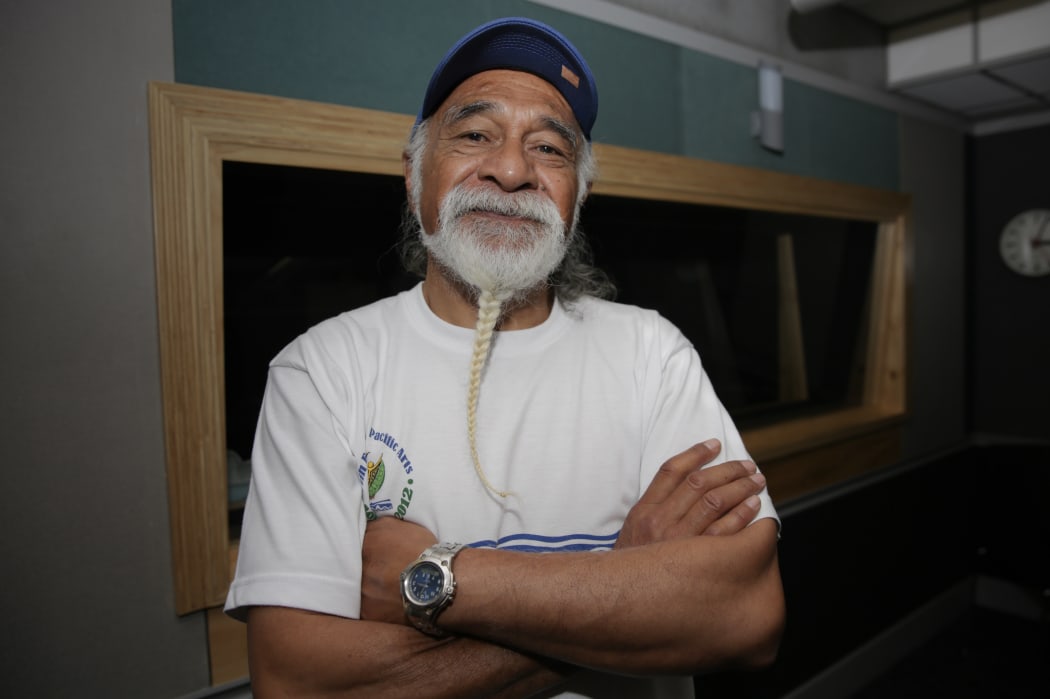
Tigilau Ness Photo: Cole Eastham-Farrelly
“I said, ‘no sir.'
'What about these white boys who have hair growing below their collar,’ they were surfies from Piha. He said, ‘no get a haircut.’ I got angry and upset and stormed out of the office,” Ness said.
“As I was leaving the foremost thought in my mind was that my mother was going to be very upset.”
Alec Toleafoa said parents weren’t all that keen on their teenage children fighting back against discrimination.
“They had this fundamental, I think it was a cultural understanding that we’re visitors, and our relationship to authority was that authority is always right and it’s always to be respected,” he said.
That view continued even through the days of the dawn raids. “We were seen as not respecting authority, in fact we were challenging authority in a way that grated against the popular thinking in the Pacific communities, so many of us were branded as the black sheep and troublemakers and all kinds of things.”
But Anae said the Polynesian Panthers was different. Like her, they were born here. And they weren’t going to stand for it.
“We weren’t from our villages in Samoa or Niue, we were born in New Zealand."
"That was a brand-new identity … most of us weren’t able to express that,” she said. “We created this brand-new identity in terms of letting New Zealand know who we were, and we were here to stay.”
The first meeting of the Panthers 48 years ago saw a couple of dozen young people pile into the lounge of Fred Schmidt’s Keppell Street house.
It was an interesting mix. There were gang members and ex-gang members. There were people like Will ‘Ilolahia, fresh out of prison for assault. And those like Melani Anae, a first-year university student who had snuck out of home that night. Most were still under 20.
Their models, the Black Panthers, famously dressed in black and weren’t shy about taking up arms either.
The Polynesian Panthers wore a lot of black too but they didn’t carry weapons. Their goal was to be accepted, not dismissed as another gang - even by their own community.
They began by organising homework centres, tenancy support groups and community shows, to build a reputation of respectability.
“We did old folks home concerts around Ponsonby and Grey Lynn to dispel the stereotypes of us as thugs and rapists and murderers,” she said.
“A lot of the comments from some of the old palagi people at these shows was, ‘oh, you speak English!’”
The Panthers also started a food cooperative, where they ordered fruit, vegetables, bread and meat in bulk, and sold it on to families around the area at a third of the price. They ran a bus service so families could visit Paremoremo Prison and they started after school homework centres in Ponsonby and Grey Lynn.
They joined Māori movements, like the land hikoi and the Bastion Point occupation. The Panthers were on the front line of the dawn raids, picketing the Immigration Minister’s house early one morning.
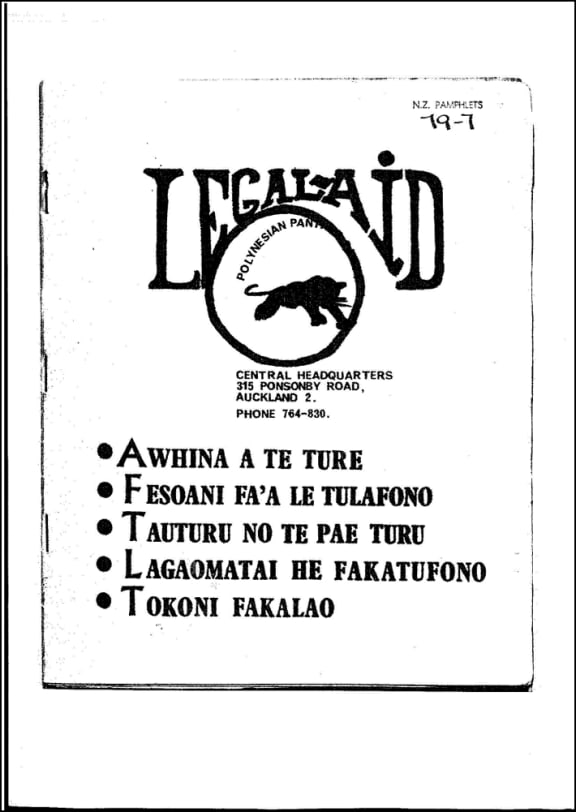
The Legal Aid handbook created for the Polynesian Panthers by David Lange. Photo: Melani Anae
They created a legal aid book and spread it widely around Ponsonby. The book was drawn up by a prominent lawyer from Mangere, the future Prime Minister David Lange. Toleafoa said the book – which included a poster about what to do when the police came knocking – was liberating.
“It was freedom, it was power that we never had before,” he said. “We didn’t know what our legal rights were, we didn’t know that when you’re being stood over by a policeman … you can imagine a 14 or 15-year-old kid in Ponsonby being stood over by a Pākehā policeman in a uniform, and you’re able to say to this guy, I don’t need to answer your questions."
But as ‘Ilolahia later discovered when he was arrested, the police weren’t fans of the book.
“I was picked up by the cops on the basis that we were putting out false information. In the station they were getting ready to beat [me] up. Normally when you’re in the cop station they’d beat you up with a rolled newspaper or a wet towel so it’s hurtful but doesn’t mark,” he recalled.
“They were surprised when I said it was David Lange who was the author, and I said you should go and charge him."
Mr Lange was never arrested for writing the legal aid book.
But for all their community work, the panthers were also there to rattle authority. They wanted to be a menace. And most of all, they wanted the police and government to know they were there. One of the main means of achieving this was with what they called their P.I.G. Patrols.
“Which stands for Police Investigation Group,” said ‘Ilolahia.
“We flipped the roles,” said Toleafoa. “Up to that point we were the suspects, they were stalking us in our communities and stopping us on the streets.
"We were the watchdogs; they became the suspects.”
“They didn’t like it because we made our presence known. At every site they stopped we were always there, and they didn’t like this idea of being followed,” said Toleafoa.
Beyond the community groups, the Panthers also had an entire military wing which garnered widespread attention. ‘Ilolahia said that was an essential component to their plan.
“The thing about the Panther … it never attacks. But if it’s attacked itself and it’s caught in a situation that calls for self-defence, it will respond.”
And it was effective, especially against landlords who were exploiting the community.
“They were charging exorbitant rents and they weren’t maintaining. If those structures were here now, they’d be condemned as unfit for human habitation,” said Toleafoa.
“The landlords were identified, their houses were noted,' ‘Ilolahia added. "The landlords would come out and find some of their wheels on their cars had disappeared, or find a whole bunch of rubbish at their front door.”
Throughout the 1970s the Polynesian Panthers became a prominent force, with many friends and foes. They met the mayor, and in 1972 won a Governor General’s Youth Award for community service.
But they also had frequent confrontations. The Panthers went on protest marches and barricaded themselves into houses where Pasifika people had been evicted. The military wing was always having run-ins with the police. In 1976, their Ponsonby Road headquarters were raided.
They also formed an international network: Anae visited the United States and met with the Black Panthers, who sent her home with a pile of resources. 'Ilolahia went to Australia, to help with the Aboriginal rights movement there.
The Panthers were part of the 1981 Patu Squad protesting the Springbok tour at Auckland's Eden Park. This would turn out to be their last official act.
“What we did was just let New Zealand know that we were here to stay and that to make a better place we had to work together and they had to stop the racism,” said Anae.
“We raised the beast, we brought it to everybody’s attention. Back then, the push back against racism came from organised groups like Panthers, Ngā Tamatoa, but today it’s coming from ordinary New Zealanders.
"That’s what I see the legacy as.”
The Polynesian Panthers never officially disbanded and nearly 50 years since that winter’s night in Grey Lynn, the energy is still there. They spend most of their time visiting schools now, telling their stories to new generations hungry to learn. They still wear black and they’re still rallying against what they see as injustices, having just returned from the land protest at Ihumātao.
As they say, “Once a Panther, always a Panther.”
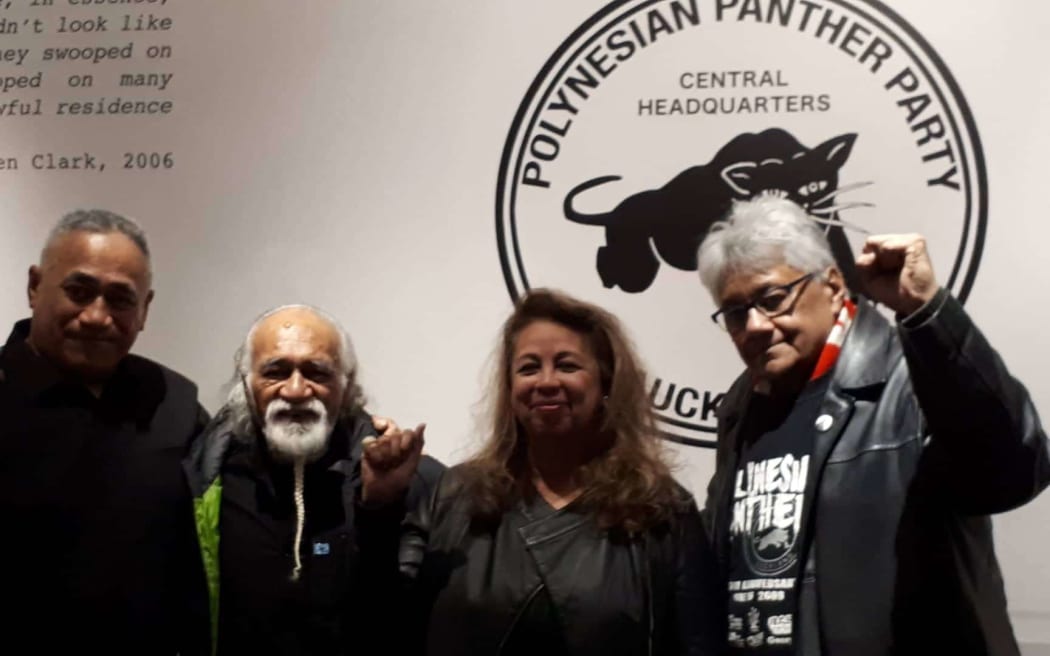
Four of the founding Polynesian Panthers at Pataka on Thursday, from left to right, Alec Toleafoa, Tigilau Ness, Melani Anae, and Will Ilolahia. Photo: RNZ / Moera Tuilaepa-Taylor
This episode of Eyewitness was made using audio from Ngā Taonga Sound and Vision.

Photo: Ngā Taonga Sound & Vision


